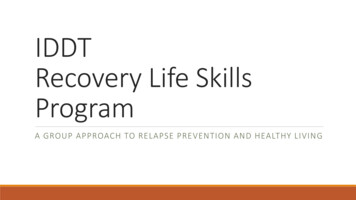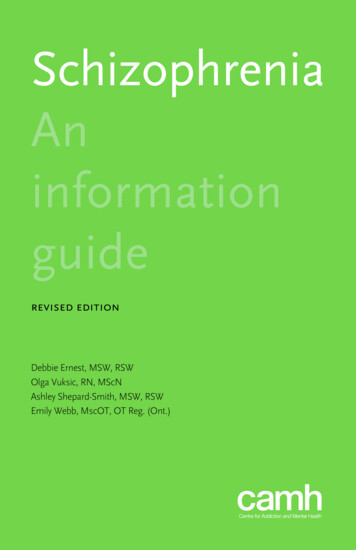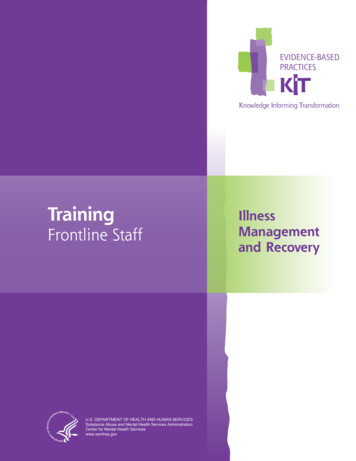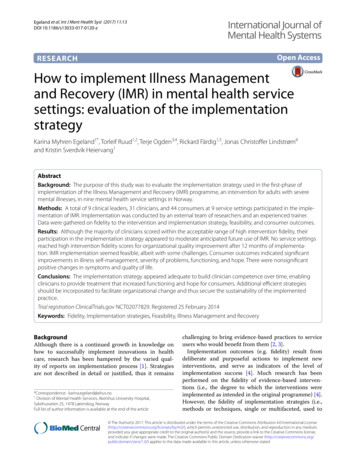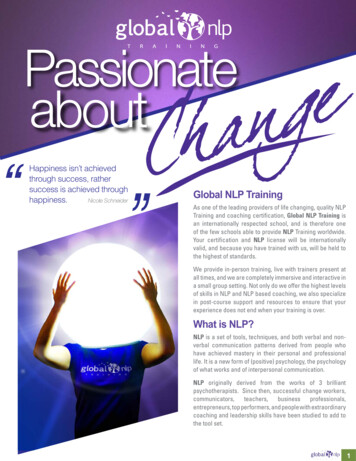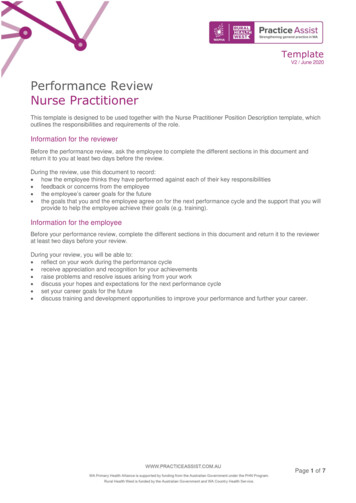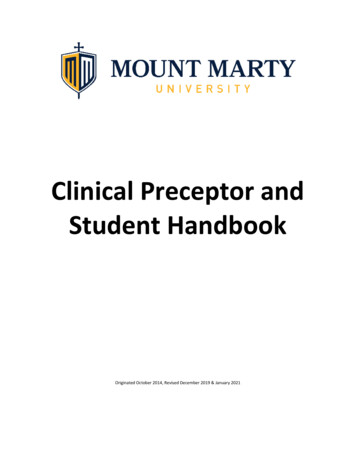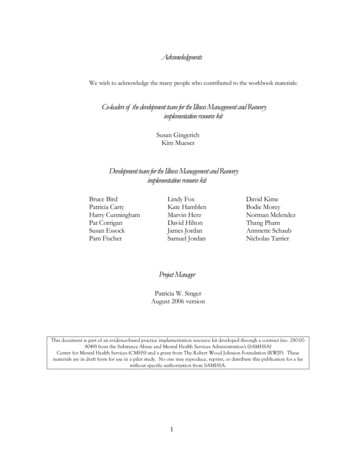
Transcription
AcknowledgmentsWe wish to acknowledge the many people who contributed to the workbook materials:Co-leaders of the development team for the Illness Management and Recoveryimplementation resource kitSusan GingerichKim MueserDevelopment team for the Illness Management and Recoveryimplementation resource kitBruce BirdPatricia CartyHarry CunninghamPat CorriganSusan EssockPam FischerLindy FoxKate HamblenMarvin HerzDavid HiltonJames JordanSamuel JordanDavid KimeBodie MoreyNorman MelendezThang PhamAnnnette SchaubNicholas TarrierProject ManagerPatricia W. SingerAugust 2006 versionThis document is part of an evidence-based practice implementation resource kit developed through a contract (no. 280-008049) from the Substance Abuse and Mental Health Services Administration's (SAMHSA)Center for Mental Health Services (CMHS) and a grant from The Robert Wood Johnson Foundation (RWJF). Thesematerials are in draft form for use in a pilot study. No one may reproduce, reprint, or distribute this publication for a feewithout specific authorization from SAMHSA.1
DRAFT2IMR Workbook
Table of ContentsPart 1: Basics of Illness Management and Recoverypage 5An Overview of Illness Management and RecoveryThe Importance of Recoverypage 8The Importance of Helping People Set and Pursue Personal Goalspage 9Logisticspage 10Core Values in Illness Managementpage 18Teaching Principlespage 21Appendices1. Orientation Sheet2. Knowledge and Skills Inventory3. Progress notes4. Significant Others5. Goals Set in the Program6. Step-By-Step Problem-solving and Goal Achievement7. References8. Outcome measure: Client version9. Outcome measure: Clinician versionpage 39page 41page 44page 45page 46page 47page 48page 52page 56Part 2: Practitioners’ Guidelines for the Educational HandoutsChapter I.Recovery Strategiespage 61Chapter II.Practical Facts about Schizophrenia/BipolarDisorder/Depressionpage 71Chapter III.The Stress-Vulnerability Modeland Strategies for Treatmentpage 79Chapter IV.Building Social Supportpage 85Chapter V.Using Medication Effectivelypage 91Chapter VI.Drug and Alcohol Usepage 99Chapter VII.Reducing Relapsespage 107Chapter VIII. Coping with Stresspage 113Chapter IX.Coping with Problems and Persistent Symptomspage 121Chapter X.Getting Your Needs Met in the Mental Health Systempage 127DRAFT3IMR Workbook
Part 3: Educational HandoutsHandout #1Recovery Strategiespage 133Handout #2a Practical Facts About Schizophreniapage 163Handout #2b Practical Facts About Bipolar Diseasepage 197Handout #2c Practical Facts About Depressionpage 229Handout #3The Stress – Vulnerability Model andTreatment Strategiespage 253Handout #4Building Social Supportpage 273Handout #5Using Medication Effectivelypage 301Handout #6Drug and Alcohol Usepage 343Handout #7Reducing Relapsespage 373Handout #8Coping with Stresspage 403Handout #9Coping with Problems and Persistent Symptomspage 435Handout #10 Getting Your Needs Met in the Mental Health Systempage 475Part 4: IMR Group Manual: A Session by Session GuideAn Introduction:Conducting IMR Groupspage 503Group Guidelines #1Recovery Strategiespage 509Group Guidelines #2Practical Facts About Mental Illnesspage 521Group Guidelines #3The Stress – Vulnerability Model andTreatment StrategiesGroup Guidelines #4 Building Social Supportpage 531Group Guidelines #5Using Medication Effectivelypage 555Group Guidelines #6Drug and Alcohol Usepage 565Group Guidelines #7Reducing Relapsespage 579Group Guidelines #8Coping with Stresspage 589Group Guidelines #9page 539Coping with Problems and PersistentSymptomsGroup Guidelines #10 Getting Your Needs Met in the Mental HealthSystempage 601Educational Handout #2: Practical Facts About Mental Illness(Adapted for group use)page 623DRAFT4page 615IMR Workbook
Part 1The Basics of Illness Managementand RecoveryI.An Overview of the Illness Management and Recovery ProgramThe Illness Management and Recovery Program consists of a series ofweekly sessions where mental health practitioners help people who haveexperienced psychiatric symptoms to develop personalized strategies formanaging their mental illness and moving forward in their lives. The programcan be provided in an individual or group format, and generally lasts betweenfour and ten months. In the sessions, practitioners work collaboratively withpeople, offering a variety of information, strategies, and skills that people can useto further their own recovery. There is a strong emphasis on helping people setand pursue personal goals and helping them put strategies into action in theireveryday lives.1. Materials for Providing the Illness Management and Recovery ProgramIn the Practitioners’ Workbook (this document) there are two sets ofmaterials for Illness Management and Recovery: The Practitioners’ Guide (thisdocument) and Educational Handouts. The educational handouts containpractical information and strategies that people can use in the recovery process.The handouts are not meant to stand alone. Practitioners are expected tohelp people select and put into practice the knowledge and strategies that aremost helpful to themselves as individuals. The following topics are covered inten educational handouts:DRAFT5IMR Workbook
1. Recovery strategies2. Practical facts about mental illness3. The stress-vulnerability model and treatmentstrategies4. Building social support5. Using medication effectively6. Drug and Alcohol Use7. Reducing Relapses8. Coping with stress and common problems9. Coping with symptoms10. Getting your needs met in the mental healthsystemPart 1 of the Practitioners’ Guide contains overall strategies for conductingthe program, and Part 2 contains practitioner guidelines for using each of theeducational handouts to conduct sessions. The guidelines in Part 2 containspecific suggestions for using motivational, educational, and cognitive behavioraltechniques to help people use strategies from the handouts in their daily lives. Italso provides tips for developing homework assignments and for dealing withproblems that might arise during sessions.2. Getting startedFirst, practitioners are advised to familiarize themselves with the format,content and tone of the program. This can be accomplished by first reading thefollowing: Part 1 of The Practitioners’ GuideEducational Handout #1 (“Recovery Strategies”)Practitioner Guidelines for Educational Handout #1 (“RecoveryStrategies”) in Part 2 of the Practitioners’ GuideIt is optimal for practitioners to read the remaining educational handoutsand accompanying practitioners’ guidelines before beginning to work with people.Practitioners are advised to review specific handouts and guidelines prior toaddressing these particular topic areas with people.DRAFT6IMR Workbook
3. Preparing For SessionsThe first session is usually spent on orientation, using the “OrientationSheet” (see Appendix 1) as a guide. The second (and sometimes third) sessionis spent on getting to know the person better, using the ”Knowledge and SkillsInventory” (see Appendix 2) as a guide. This inventory is focused on theperson’s positive attributes/strengths rather than their problems or “deficits.” It isimportant to gather information in a friendly, low- key manner, using aconversational tone. The remaining sessions are focused on helping people tolearn and practice the information and strategies in the educational handouts andto set and pursue their personal goals. Each session should be documented,using the Progress Note for Illness Management and Recovery (see Appendix 3).The format of the progress note helps practitioners to keep track of the person’spersonal goals, the kinds of interventions provided (motivational, educational,cognitive-behavioral), the specific evidence-based skill(s) that are taught (copingskills, relapse prevention skills and behavioral tailoring skills) and the homeworkthat is agreed upon.Before beginning each educational handout, the practitioner isencouraged to review the contents of the handout and the practitioner guidelinesof the same title in Part 2 of The Practitioners’ Guide.Most educationalhandouts will require two to four sessions to put the important principles intopractice. Preparation for sessions is most effective when practitioners review theeducational handout and the corresponding practitioners’ guidelines side-by-side,noting the goals of the handout, the specific topic headings, the probe questions,the checklists, etc. As noted above, sessions should be recorded on the formDRAFT7IMR Workbook
“Progress Note for Illness Management and Recovery” (Appendix 3). Althoughfor many people it is most helpful to go through the handouts in the order theyare listed, it is important to tailor the program to respond to individual needs. Forexample, when a person is very distressed by the symptoms he or she isexperiencing, it would be preferable to address this problem early in the programusing Educational Handout #9, “Coping with Problems and Symptoms. ”Practitioners need to be responsive to people’s concerns and use their clinicaljudgment regarding the order and pacing of handouts.II. The Importance of RecoveryThere is widespread acceptance of the importance of recovery as aguiding vision for helping people who experience psychiatric symptoms toachieve personal success in their lives. The term recovery means differentthings to different individuals. Each person is free to define it in his or her terms.For some individuals, recovery means no longer having any symptoms or signsof a mental illness. For others, recovery means taking on challenges, enjoyingthe pleasures life has to offer, pursuing personal dreams and goals, and learninghow to cope with or grow past one’s mental illness despite symptoms orsetbacks.Regardless of the personal understanding each individual develops aboutrecovery, the overriding message is one of hope and optimism. The recoveryvision is at the heart of the Illness Management and Recovery Toolkit. Throughlearning information about mental illness and its treatment, developing skills forreducing relapses, dealing with stress, and coping with symptoms, people canDRAFT8IMR Workbook
become empowered to manage their own illness, to find their own goals forrecovery, and to assume responsibility for directing their own treatment. Peoplewho experience psychiatric symptoms are not passive recipients of treatment,and the goal is not to make them “comply” with treatment recommendations.Rather, the focus of Illness Management and Recovery is providing people withthe information and skills they need in order to make informed decisions abouttheir own treatment.Broadly speaking, the goals of Illness Management and Recovery are to: lll.Instill hope that change is possibleDevelop a collaborative relationship with a treatment teamHelp people establish personally meaningful goals to strive towardsTeach information about mental illness and treatment optionsDevelop skills for reducing relapses, dealing with stress, and copingwith symptomsProvide information about where to obtain needed resourcesHelp people develop or enhance their natural supports for managingtheir illness and pursuing goalsThe Importance of Helping People Set and Pursue Personal GoalsBeing able to set and pursue personal goals is an essential part of recovery. Atthe same time that information and skills are being taught in the IllnessManagement and Recovery Program, people are also helped to define whatrecovery means to them and to identify what goals and dreams are important tothem. The first educational handout, “Recovery Strategies,” contains specificinformation about setting goals. However, throughout the entire program,practitioners help people set meaningful personal goals and follow up regularlyon those goals. As people gain more mastery over their psychiatric symptoms,they gain more control over their lives and become better able to realize theirvision of recovery. In each session of the program, practitioners should follow upDRAFT9IMR Workbook
on the participants’ progress towards their goals. “Goals Set in the IllnessManagement and Recovery Program” (Appendix 5) helps practitioners to keeptrack of a person’s goals. Another form, “Step-By-Step Problem-Solving andGoal Achievement” (Appendix 6) is useful for helping a person plan the steps forachieving a goal (or solving a problem).III.LogisticsThe content and teaching methods used in the Illness Management andRecovery Program are derived from multiple studies of professionally basedillness management training programs for people who have experiencedpsychiatric symptoms. Information is taught using a combination of motivational,educational, and cognitive-behavioral teaching principles. Critical information issummarized in educational handouts that are written for people who experiencepsychiatric symptoms but are also suitable for distribution to anyone with aprofessional or caring relationship with a person who experiences psychiatricsymptoms (such as a case manager or a family member).The information and skills taught in Illness management and Recovery areorganized into ten topic areas: recovery strategies, practical facts about mentalillness, the stress-vulnerability model, building social support, using medicationeffectively, drug and alcohol use, reducing relapses, coping with stress, copingwith problems and symptoms, and getting your needs met in the mental healthsystem. There are educational handouts and practitioners’ guidelines for eachtopic area.DRAFT10IMR Workbook
Each topic is taught using a combination of motivational, educational, andcognitive behavioral methods. Also, in order to help people apply the informationand skills that they learn in the sessions to their day-to-day lives, the practitionerand the person collaborate to develop homework assignments at the end of eachsession. These homework assignments are tailored to the individual, to help himor her practice strategies in “the real world.” Because developing and enhancingnatural supports is a goal of Illness Management and Recovery, people areencouraged to identify significant others with whom they can share the handoutmaterials and who may support them in applying newly acquired skills orcompleting homework.The amount of time required to teach Illness Management and Recoverydepends on a variety of factors, including people’s prior knowledge and level ofskills, the problem areas that they would like to work on, and the presence ofeither cognitive difficulties or severe symptoms that may slow the learningprocess. In general, between four and ten months of weekly sessions of 45 to60 minutes may be required to teach Illness Management and Recovery.Following the completion of the ten topic areas, people may also benefit fromeither booster sessions or participation in support groups aimed at using andexpanding skills.These following sections discuss different topics related to the logistics ofteaching Illness Management and Recovery. Included is information about theteaching format, session structure, session length, location, use of educationalhandouts, selection of program participants, involvement of significant others,and practitioner qualifications.DRAFT11IMR Workbook
1. Selection of Participants for the Illness Management and Recovery ProgramWho is most likely to benefit from Illness Management and Recovery?While many people will be familiar with at least some of the information and skillstaught, almost everyone who experiences psychiatric symptoms will find they canlearn something new from the program. Educational handouts have been writtencovering three common diagnoses: schizophrenia, bipolar disorder and majordepression. Therefore, people with these diagnoses are most likely to benefitfrom participation in the program. However, because much of the informationpresented in Illness Management and Recovery is not specific to any one mentalillness, people with other psychiatric diagnoses may also benefit. In such cases,people may benefit from the brief review of their symptoms with the practitioner,guided by the DSM-IV or educational handouts from other sources (seereferences).People who experience psychiatric symptoms may benefit from training inIllness Management and Recovery regardless of how long they have had theirmental illness. For anyone who has recently had a relapse, or is under extremestress due to personal life circumstances, it may be preferable to wait until his orher symptoms have stabilized and undue life stresses have been resolved beforebeginning the program. Some people are often in crisis, due to problems suchas homelessness, substance abuse, medical illness, or poverty. Rather thanpostponing Illness Management and Recovery for long periods of time (orperhaps forever), it is preferable to engage the person in the program. Whenpeople learn more about their symptoms and develop skills for coping withDRAFT12IMR Workbook
problems, they often feel more confident and can be more effective at resolvingsome of their life stresses.2. Format of the programIllness Management and Recovery can be taught using either anindividual or group format. Each format has its advantages. The primaryadvantages of the individual format are that the teaching of material can be moreeasily paced to meet the person’s needs, and more time can be devoted toaddressing his or her specific concerns. The main advantages of the groupformat are that it provides people with more sources of feedback, motivation,ideas, support, and role models. Teaching in a group may also be moreeconomical.One option that combines the advantages of both individual and groupformats is to teach the core material in an individual format, and then provide anoptional support group that serves as a vehicle for providing social support,sharing coping strategies, and encouragement for people to pursue theirpersonal recovery goals. The practitioner guidelines provided in this manual arebased on an individual format, which practitioners can adapt if they choose toteach the materials in a group format.3. Structure of the sessionsThe practitioner should structure the sessions of Illness Management andRecovery to follow a predictable pattern. The following structure isrecommended:DRAFT13IMR Workbook
Informal socializing and identification of anymajor problemsReview previous session(s)Review homeworkFollow-up on goalsSet agenda for current sessionTeach new material or review previouslytaught materialAgree on new homework assignmentSummarize progress made in currentsession1-3 minutes1-3 minutes3-5 minutes1-3 minutes1-2 minutes30-40minutes3-5 minutes3-5 minutes4. Session LengthSessions generally last between 45 and 60 minutes. The most criticaldeterminant of session length is the person’s ability to be engaged and learn therelevant material. Some people may have limited attention spans,comprehension problems, or severe symptoms that make it difficult to focus formore than 30 minutes. It may be desirable to take breaks during a teachingsession or to simply have brief sessions. Another option is to conduct morefrequent, brief sessions, such as meeting for 20 to 30 minutes two or three timesa week.5. LocationTeaching sessions can be conducted in almost any location that isconvenient for the person. Examples of possible locations include the mentalhealth center, the person’s home, the home of a family member, or a publicsetting (e.g., coffee shop). The setting should also have ample lighting (to readthe handouts), comfortable seating, and some privacy. Regardless of thelocation, the practitioner should strive to create an environment that is quiet, freeDRAFT14IMR Workbook
of unnecessary distractions, and conducive to learning and practicing thematerial.6. Educational HandoutsThe educational handouts are written in simple, easy-to-understandlanguage, and include informative text, summary boxes, probe questions,checklists, and planning sheets for each topic. There are ten topic areas, whichwere noted earlier. These handouts can be used to help people learn thematerial in a number of different ways.First, it is important to review the contents of the handout. There aredifferent ways to do this, depending on the individual. Practitioners can presentthe material in a conversational tone by summarizing the key points andproviding relevant examples. Practitioners can offer to take turns readingparagraphs or ask people to read the material on their own and use the sessionsfor discussion. It is important to make reviewing the contents of the handout aninteractive process, by pausing frequently to ask questions to check forunderstanding and to learn more about the person’s point of view. At all timescommunication should be a “two-way street” between the person and thepractitioner; it must never seem like a lecture.Second, it is important for people to have a chance to personalize theinformation from the handout. Practitioners should allow time for people toanswer the probe questions provided in each topic section of the handout and tocomplete the checklists and questionnaires. There are also planning sheets thatpeople can use to strategize how they might use the information in their ownsituation.DRAFT15IMR Workbook
Third, homework assignments can be developed that involve reviewingsome of the handout information or putting it into practice. Many of the checklistsin the handouts involve helping people to select the strategies they are mostinterested in trying out. These checklists can then be used to develop homeworkassignments to help people put their strategies into action between sessions.Fourth, the person can give selected educational handouts to familymembers or other supporters to inform them about Illness Management andRecovery. This will often lead to a discussion of the material in the handout,which furthers the learning process.Practitioners must keep in mind that while some people may enjoyreading aloud, others may have minimal reading skills and may be embarrassedto do so. Practitioners can either simplify each of the main points without readingthem directly from the handout or they can alternate reading certain sections outloud and summarizing others.7.Involvement of Significant OthersMany people benefit from the involvement of significant others in helpingthem manage their mental illness and take steps towards recovery. Involvementof significant others may be helpful in several ways. By providing accurateinformation to significant others who may be misinformed about mental illness, itmay reduce their criticism of the person who experiences symptoms. Whenpeople inform significant others about the goals they are working on as part ofIllness Management and Recovery, it can generate support and help in achievingthose goals. In addition, when people choose to ask significant others to helpDRAFT16IMR Workbook
them practice newly learned skills outside of teaching sessions, it can increasethe chances of the practice being successful.Significant others can be involved in the Illness Management andRecovery Program in several ways. People can share their educationalhandouts with significant others. People can request help from them in practicingspecific skills. People can invite significant others to participate in some of thesessions. Significant others are especially helpful in sessions which involvedeveloping a relapse prevention plan (using Educational Handout #7).Practitioners should make a special effort to encourage the person to includesignificant others in this process.The decision to involve significant others in Illness Management andRecovery is always the person’s choice. When discussing the involvement ofsignificant others, the practitioner should explore with the person the benefits ofinvolving them, and respect the person’s decision about whether and in whatways to involve them. Appendix 4 contains a list of significant others that peoplemay want to consider asking to become involved in the Illness Management andRecovery Program.8. Practitioner QualificationsPractitioners who teach Illness Management and Recovery must be warm,kind, empathic individuals who are knowledgeable about mental illness and theprinciples of its treatment. Good listening skills are important, including the abilityto reflect back what the practitioner has heard and seek clarification whennecessary. Good eye contact, a ready smile, and a good sense of humor areadditional skills that can put people at ease.DRAFT17IMR Workbook
Specific teaching skills are also important. Practitioners must have theability to structure sessions so that they follow a predictable pattern. They mustalso be able to establish clear objectives and expectations and to set goals andfollow through on them.Another important practitioner attribute is the ability to take a “shaping”approach to increasing a person’s knowledge and skills. Shaping means thatpractitioners recognize that it often takes people a significant period of time tolearn new information and skills, and that it is important to give positive feedbackfor their efforts and small successes along the way (see more on this in SectionIV, under Cognitive-Behavioral Strategies). A shaping attitude towards settingand pursuing goals means that even very small steps are acknowledged andvalued, which encourages people to continue in their efforts towards achievingtheir personal goals.V.Core Values in Illness Management and RecoveryTeaching people how to manage their mental illness and make progresstowards recovery is predicated on several core values that permeate therelationship between the practitioner and the person who experiences psychiatricsymptoms. These values include hope, personal choice, collaboration, respect,and recognizing people as the experts in their own experience of mental illness.1. Hope is the key ingredient.First and foremost, the process of teaching Illness Management andRecovery involves conveying a message of hope and optimism. The long-termcourse of mental illness cannot be predicted, and no one can predict anyone’sDRAFT18IMR Workbook
future. Studies have shown, however, that individuals who actively participate intheir treatment and who develop effective coping skills have the most favorablecourse and outcome, including a better quality of life. This ability to influenceone’s own destiny is the basis for hope and optimism about the future.Practitioners must first have hope and optimism themselves in order toconvey these beliefs to the people they are working with. People whoexperience psychiatric symptoms often report that having another person believein them is an empowering and validating experience. In teaching IllnessManagement and Recovery, practitioners present information and skills aspotentially useful tools that they have confidence that people can use in pursuingtheir goals. It is vital that the practitioners retain an attitude of hope andoptimism, even when the people they are working with may be pessimistic.2. The person is the expert in his or her own experience of mental illness.Practitioners have professional expertise in their knowledge about mentalillness, the principles of its treatment, and in strategies for dealing with stress,coping with symptoms, and pursuing goals. People who experience psychiatricsymptoms have expertise in the experience of mental illness, how others react tothem, and what has been helpful and what has not. Just as practitioners sharetheir expertise regarding information and skills for managing and recovering frommental illness, people who experience psychiatric symptoms share theirexpertise with the practitioner about how they experience mental illness and whatstrategies work for them. It is important seek out the person's expertise, becauseeach individual has a unique experience with mental illness and a uniqueresponse to treatment. By paying close attention to people’s expertise,DRAFT19IMR Workbook
practitioners will be more effective in assisting them in making progress towardstheir goals.3. Personal choice is paramount.The overriding goal of Illness Management and Recovery is to give peoplethe information and skills they need to make choices regarding their owntreatment. The ability and right of people to make their own decisions isparamount, including instances when they make decisions that differ from therecommendations made by their treatment providers. There are certain rareexceptions to this principle, as when there are legal constraints such as aninvoluntary hospitalization to protect the person from himself/herself or others. Ingeneral, practitioners should avoid placing pressure on people to make certaintreatment decisions, and must instead accept their decisions and work with themto evaluate the consequences in terms of their personal goals.4. Practitioners are collaborators.While practitioners are teachers, they are also collaborators in helpingpeople learn how to cope with their illness and make progress towards theirgoals. The collaborative spirit of Illness Management and Recovery reflects thefact that the practitioner and the person who experiences psychiatric symptomswork together side-by- side in a non-hierarchical relationship. The practitionercan think of himself or herself as a consultant with expertise in the topic of IllnessManagement and Recovery.DRAFT20IMR Workbook
5. Practitioners demonstrate respect for people who experience psychiatricsymptoms.Respect is a key ingredient for successful collaboration in IllnessManagement and Recovery. Practitioners need to respect people whoexperience psychiatric symptoms as fellow human beings, capable decisionmakers, and active participants in their own treatment. Practitioners need toaccept that individuals differ in their personal values, and must respect the rightof people to make informed decisions based on these values. Practitioners mustalso accept the fact that people may hold different opinions and that theseopinions should be respect
DRAFT 3 IMR Workbook Table of Contents . Part 1: Basics of Illness Management and Recovery . An Overview of Illness Management and Recovery page 5. The Importance of Recovery page 8 . The I
